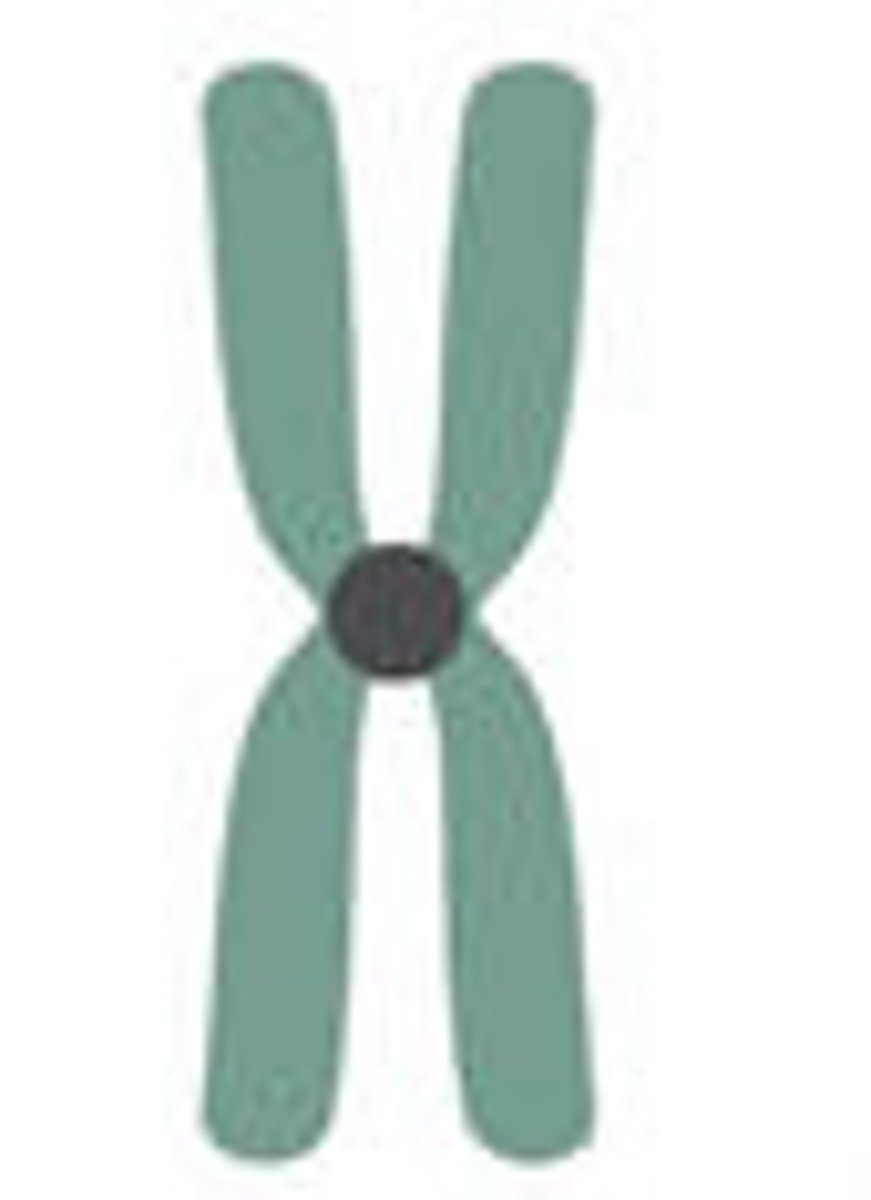Chapter 6- Dr. Kim
1/72
There's no tags or description
Looks like no tags are added yet.
Name | Mastery | Learn | Test | Matching | Spaced |
|---|
No study sessions yet.
73 Terms
Chromosome variation is called ____.
rearrangement
What are the stable ends of chromosomes?
telomeres
centromere
constricted region of the chromosome where the kinetochores form and spindle microtubules attache
Four major types of chromosomes
metacentric, submetacentric, acrocentric, telocentric
metacentric chromosome

Submetacentric

Acrocentric chromosome

telocentric chromosome

Karyotype
the complete set of chromosomes in an organism
How are karyotypes presented?
as a picture of metaphase chromosomes
Different staining methods present different _____.
banding patterns
Chromosome mutations
variations in the number and structure of chromosomes
What are the types of chromosome mutations?
duplication, deletion, inversion, translocation
What happens during chromosome duplication?
a segment of the chromosome is duplicated
AB*CDEFG--> AB*CDEFEFG
Tandem Duplication
AB*CDEFG-->AB*CDEFGEF
Displaced Duplication
AB*CDEFG-->AB*CDEFFEG
Reverse Duplication
What must the EF do to allow the homologous sequences of the chromosome to align?
the duplicated EF region must loop out
What does unbalanced gene dosage lead to?
developmental abnormalities
What may be affected by the relative amounts of gene products?
development
Developmental processes often require _____.
the interaction of many genes
What happens in chromosome deletion?
a segment of the chromosome is deleted
When are many deletions lethal?
in the homozygous state
Why are many genes lethal in the homozygous state?
due to the loss of essential genes
What are the effects of individuals being heterozygous for deletion?
-imbalances in the amounts of genes produced
-deleted dominant allele allows the undeleted recessive allele to express
-some genes require two copies for normal function
pseudodominance
Deleted dominant allele allows the undeleted recessive allele to express
haploinsufficient gene
some genes require two copies for normal function
When does the normal chromosome loop out during chromosome pairing?
prophase I
Cri-du-chat syndrome
"cry of the cat"
Where is the deletion of the cri-du-chat syndrome?
deletion on the short arm of chromosome 5
What happens in during the inversion of a chromosome?
a segment of the chromosome is turned 180 degrees
AB*CDEFG --> AB*CFEDG
Paracentric inversion
AB*CDEFG --> ADC*BEFG
Pericentric inversion
What are the effects on gene function?
disruption of genes
position effect
Where does the disruption of genes occur?
at the chromosomal break & insertion site
What forms in prophase I of meiosis, which allows homologous sequences to align?
an inversion loop
What does chromosome 4 differ in?
humans and chimpanzees
In a translocation, a segment of a chromosome moves from one chromosome to a ______ chromosome or to another place on the same chromosome.
nonhomolgous
Where does the position effect happen?
under the control of different regulatory sequences
Robertsonian Translocation
Long arms of two acrocentric chromosomes become joined to a common centromere through translocation, generating a long metacentric chromosome
When does deletion occur?
when chromosomes are heterozygous
Robertsonian Translocation is a type of _____ translocation.
reciprocal
Aneuploidy
A change in the number of individual chromosome
Polyploidy
A change in the number of chromosome setChapter 6-2
What are the types of Aneuplodiy?
Nullisomy
monosomy
trisomy
tetrasomy
Nullisomy
loss of one homologous chromosome pair (2n-2)
Monosomy
loss of a single chromosome (2n-1)
Trisomy
one extra chromosome (2n+1)
Tetrasomy
one extra chromosome pair (2n+2)
What are the major causes of aneuploidy?
1) deleted centromere
2)Robertsonian Translocation
3)Nondisjunction
Deleted centromere
Chromosome may be lost during mitosis or meiosis
Robertsonian translocation
Small chromosome lost during mitosis or meiosis
Nondisjunction
Failure of separation of homologous chromosomes or sister chromatids during mitosis or meiosis
Major consequences
abnormal gene dosage
abnormal gene dosage
Interferes with normal development
Uniparental disomy is a type of _____.
Aneuploidy
Uniparental Disomy
An individual has two copies of a chromosome from one parent and no copy from the other
When may uniparental disomy arise?
when trisomic embryo loses one of the triplicate chromosomes early in development
Mosaicism
Different cells within the same individual have different chromosome constitutions (Due to nondisjunction in a mitotic division)
autopolyploidy aries from:
accidents of meiosis or mitosis
Allopolyploidy arises from:
hybridization between two species
What kind of polyploids are likely to be fertile because of potential for equal segregation during meiosis?
Even-numbered polyploids
What kind of polyploids have unpaired chromosomes and usually are sterile?
Odd-numbered polyploids
Most seedless fruits are ____.
triploid
Homologous chromosomes can pair or not pair during _____.
meiosis
What level of polyploids do not usually produce viable offspring?
triploids
Allopolyploidy is the hybridization between two ____.
species
Amphidiploid
Two combined diploid genomes
In polyploidy, what is cell volume associated with?
nuclear volume which is determined by genome size
Many polyploids are physically larger than diploids
true
____ are common in crop plants.
polyploids
A diploid species has 2n = 52 chromosomes. If you found monosomy in a member of this species, how many chromosomes would it have?
51
If a diploid species (2n) has 52 chromosomes,how many chromosomes would a triploid have?
78